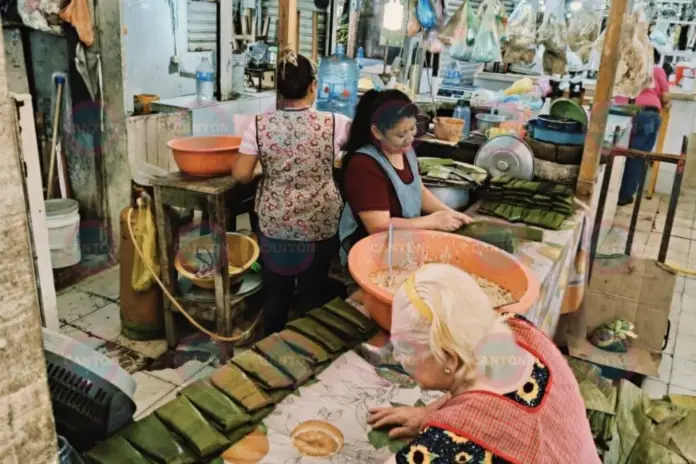
Amidst banana leaves, dough with chipilín, and the smell of cooked stews, Teresa Ruiz de la Cruz, better known as “La Güera” or “La vende tamal,” laughs as she recounts how her life has revolved around selling tamales in Tabasco. Six years ago, after 25 years selling snacks, she decided to dedicate herself completely to this business.
However, this year, the increase in the prices of inputs has affected her economy. Compared to last year, inputs have increased by up to 20 percent. For example, the tamal de presa, which she used to sell for 15 pesos, now costs 20, while the chipilín one went from 12 to 17 pesos.
“La Güera” explains that with a thousand pesos she bought what she needed for her production, but now she spends around 1,200 pesos. The bundle of banana leaves, for example, has had notable variations in its cost. While in 2023 it was sold for up to 50 pesos, this year it has dropped to 25, although with the warning that if the rains continue, prices could skyrocket again.
Price increase in inputs
In her business, which she maintains outside the peasant market, Teresa Ruiz works hand in hand with her daughters Dulce Jazmín and Ana Rufina, and hopes that the upcoming festivities of San Judas Tadeo and the Day of the Faithful Departed will allow her to sell more tamales. Until that date arrives, she continues working from Monday to Saturday, between 2 and 7 in the afternoon, selling her traditional tamales and tamalitos.
Prices 2024 vs 2023:
Kilogram of meat: 90 pesos (2024) / 80 pesos (2023)
Kilogram of dough: 15 pesos (2024) / 12 pesos (2023)
Liter of lard: 50 pesos (2024) / 40 pesos (2023)
Banana leaf (5 leaves): 25 pesos (2024) / 50 pesos (2023)
“TO” leaf (10 leaves): 30 pesos (2024) / 50 pesos (2023)
Kilo of tomato: 30 pesos (2024) / 40 pesos (2023)
Kilo of onion: 35 pesos (2024) / 30 pesos (2023)
Bunch of chipilín: 7
Tamale preferences according to customers:
Mirta Pérez, housewife: “Mass-strained with pork, beans, and maneas revueltos with chipilín and pork.”
José Vasconcelos, taco maker: “I like the ones with masa strained with pork, new corn, and the classic maneitas.”
María Hipólito Pérez, employee: “The traditional ones with chipilín and masa strained, as long as they are chicken.”
Jade Celeste, employee: “Mass-strained chipilín with meat, masa strained, but preferably chicken.”
Rosario Hernández Sarracino, merchant: “I love the ones with masa strained and the maneitas with chipilín.”
Jaime Álvarez Vázquez, merchant: “I love the ones with chipilín, but fried.”
Source: tabasco






